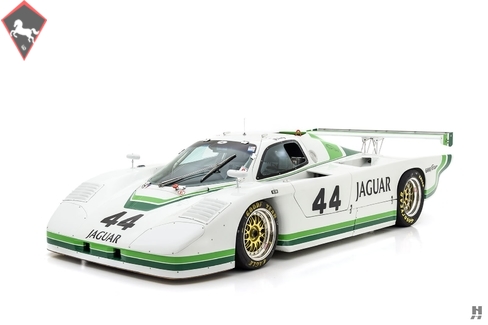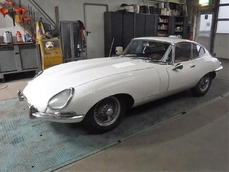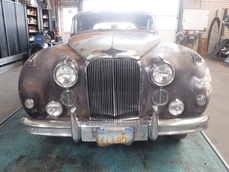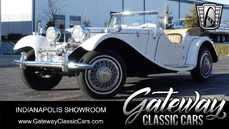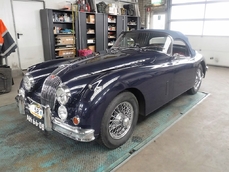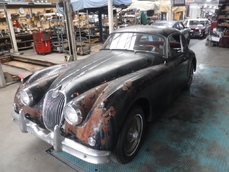Jaguar Other 1984
General description :
In the early 1980s, British Leyland was collapsing under its own weight and the entire fate of that nation’s motor industry was in peril. With the fate of storied marques like Triumph, MG, and even Jaguar in question, motor racing was low on the priority list and the funds were cut off to virtually every works or semi-works program. The ripple effect was felt across the pond in the USA as well, where longtime BL racing stalwart Bob Tullius was suddenly left without a car to run, despite his years of success with Jaguar and Triumph.
Tullius had started racing in the early 1960s, securing a D-Production national championship in 1964 at the wheel of a Triumph TR4. He worked through the ranks of American sports car racing, scoring numerous wins along the way. But Tullius was more than just a hot-shoe driver – he was a shrewd businessman who, through the creation of Group 44 Racing Inc, essentially created the modern concept of the professional racing team. Group 44 would become one of the first teams (alongside Penske Racing) to adopt a business-like approach to building and running race cars. While other teams chased the hottest car year to year, Tullius remained staunchly loyal to Triumph, MG, and Jaguar; his cars always impeccably turned out in their signature white and green livery. He maintained long-term partnerships with sponsors Quaker State Oils and Goodyear, providing them unprecedented value through promotions, press, and plenty of on-track success. Supported by British Leyland, Tullius and Group 44 developed the somewhat unwieldy V12-powered Jaguar E-type into a formidable challenger for the B-production championship. Jaguar’s stock rose further when the even less-likely XJS walked away with the 1977 and 1978 Trans Am titles. By the end of the 1970s, Tullius and his signature Group 44 cars were synonymous with Jaguar, and company bosses recognized the tremendous value of that relationship.
After the fall of Leyland, the fate of Group 44 was in jeopardy. But in late 1981, the head of Jaguar North America hinted to Bob that he shouldn’t sign with anyone until he heard from Jaguar UK. Tullius’ patience paid off when Group 44 was tapped to run a works-supported team in the hotly contested IMSA Camel GTP series, which Jaguar saw as a stepping stone to a Le Mans return. Bob jumped at the opportunity and expanded his team to build a new GTP car from the ground up and secured the talents of Lee Dykstra to design a new chassis, and Randy Wittine to pen the bodywork. Jaguar’s insistence of having Briton Patrick Head design the car was met with fierce resistance as Tullius knew he needed designers that understood the intricacies of building a car for the uniquely American GTP series. He got his way and by August of 1982, the first Group 44 Jaguar XJR-5 rolled out of the workshop.
The XJR-5 was a stunningly beautiful race car, turned out with the typical exquisite preparation that Group 44 was known for. That the XJR-5 was initially outclassed by the dominant Porsche 962 almost didn’t matter – its beauty, heritage, and ear-splitting V12 soundtrack made it an instant hit with the rabid IMSA fans. Despite being down on power compared to the turbocharged Porsche, the XJR-5 could still win races – winning several events between 1982-1986 and scoring numerous other podium finishes along the way. The Group 44 XJR-5 and XJR-7 GTP programs paved the way for Jaguar’s later Group C efforts and victory at LeMans.
Our featured XJR-5 is chassis number 010, the very last car built and raced in-period by Group 44. Approximately 13 cars in total are known, though three have been built up from spares. Chassis 010 raced in the 1984 and 1985 IMSA seasons and features numerous developments that set it apart from earlier cars. Most notable is the addition of fuel injection (early cars ran Weber carburetors) that allows the 6.0 liter Jaguar V12 to develop nearly 650 horsepower. Chassis number 010 was run in-period by a laundry list of legendary drivers – Doc Bundy, Chip Robinson, Brian Redman, Hurley Haywood and of course Bob Tullius – and it carries their signatures on the tub. According to information from Group 44, chassis 010 won the 1985 Road Atlanta 500KM with Redman and Haywood, in a one-off appearance wearing race number 04. As #44, it scored several more podiums and top-tens in its career, mainly with Tullius, Robinson, and Bundy at the helm. This car was also sent to Le Mans twice, though only to serve as a backup for chassis 06 & 08. It remained with Tullius until 2008 when it was sold to a noted racer and collector, Rick Knoop. More recently, it has participated in the Daytona Classic 24, the Palm Beach Historics and multiple Monterey Historics (with F1 veteran Stefan Johansson driving on one occasion).
Benefitting from a meticulous restoration in 2008 led by Rick Knoop and Jim Busby, XJR-5 010 presents in stunning concours-quality condition yet it remains fully sorted and ready to race. The original bodywork has been fully restored in its iconic Group 44 livery, with exquisite paintwork and detailing. The chassis and original alloy tub have been fully rebuilt, and it is plumbed and wired with the same meticulous care that Bob Tullius would have insisted upon in 1984. The thundering Jaguar V12 has been fully rebuilt by Ed Pink Racing Engines and has fewer than 25 hours since the rebuild. While capable of a screaming 8500 rpm, the current owner has wisely kept it below 6000 to ensure longevity. Mated to the engine is a freshly rebuilt Carl Haas Hewland dog-box, complete with cryo-treated gear sets and a new differential. It is reported to be very reliable and an absolute joy to drive – even at speeds approaching 200 mph on the banks at Daytona. As a testament to its quality and presentation, it has been shown at the Amelia Island Concours, and won its class at the Quail Motorsports Gathering and the Carmel Concours.
The sale of this legendary historic racer will include a comprehensive spares package consisting of spare bodywork (including a nose with headlights), suspension components, race and show wheels, spare block, new crank, and spare heads along with a complete road-going V12 with all of the necessary ancillaries needed for an additional complete spare engine build. The history and specification are fully documented with log books and spec sheets from the restoration, and numerous promotional materials and press kits are included as well.
Impeccably finished and prepared, this truly stellar, race-winning Jaguar XJR-5 is both a proven concours competitor and eligible for entry in a wide number of racing events around the world, including Historic Group C (Class 1 b), Le Mans Classic, and the HSR Classic 24 at Daytona, among many others. The GTP era was notoriously tough on cars, and it is rare to see examples from this historic period restored to such a high standard. This is an unmatched opportunity to acquire one of the best XJR-5s extant; a genuine semi-Works Jaguar racer with magnificent history at the hands of some the greatest sports car drivers of all time.
https://hymanltd.com/vehicles/6220
1984 Jaguar Other is listed sold on ClassicDigest in St. Louis by Mark Hyman for $1125000.
Car Facts
Car type : Car Make : Jaguar Model : Other Engine size : 0.0 Model Year : 1984 Location : Missouri
Sold
Seller Information
Sold
People who viewed this Jaguar Other also viewed similar Jaguar listed at ClassicDigest
Other cars listed for sale by this dealer
About Jaguar
Ah, the story of Jaguar, from its early days as the SS Cars Ltd. to its pinnacle with the D-type, and the street-going evolution in the form of the iconic E-type. There's something quintessentially British about this tale, and I'll narrate it as a British journalist might.In the Beginnings:
Our journey into the world of Jaguar begins in the 1930s, when a company known as SS Cars Ltd. emerged. Despite the unfortunate coincidence of their initials with the rising political tensions in Europe, they started producing stylish and performance-oriented cars. The SS 100, introduced in 1936, was a symbol of elegance and speed, setting the stage for what would become Jaguar.
The Birth of Jaguar:
As the shadows of World War II loomed, SS Cars Ltd. wisely decided to disassociate themselves from the SS initials. Thus, in 1945, they officially became Jaguar Cars Ltd., a name that would soon be synonymous with British luxury and performance.
The XK Series:
Jaguar's post-war era brought us the XK 120, a true sensation in 1948. With its sleek design and a powerful 3.4-liter inline-six engine, it became the world's fastest production car. The XK 120 was the blueprint for what lay ahead – Jaguars that blended style with speed in a uniquely British fashion.
The D-type Dominance:
Then came the D-type, a true racing legend. Introduced in 1954, it won Le Mans three times in the 1950s, showcasing Jaguar's engineering prowess. With its innovative monocoque construction and the iconic fin at the back, the D-type was the apex of Jaguar's motorsport success.
The E-type Emergence:
But the true turning point arrived in 1961 with the introduction of the E-type, often described by Enzo Ferrari as "the most beautiful car ever made." Its long bonnet, curvaceous body, and a 3.8-liter engine delivering exhilarating performance made it an instant classic. The E-type was not just a car; it was a work of art on wheels, and it could hit 150 mph on the road.
Street and Racing Success:
The E-type's beauty was matched by its capability on the track. The lightweight E-types were particularly successful in various racing events, cementing Jaguar's reputation as a force to be reckoned with in motorsport.
The Age of Refinement:
As we delve deeper into the Jaguar story, we find that the 1950s and 1960s were an age of refinement and expansion. Alongside the magnificent D-type and the E-type's iconic emergence, Jaguar introduced models that further solidified its reputation for luxury and performance.
The MK2:
In the late 1950s, Jaguar unveiled the MK2, a sports sedan that combined elegance with power. This sleek four-door saloon was a favorite of bank robbers and law enforcement alike, thanks to its exceptional speed and handling. The MK2 was a symbol of Jaguar's ability to blend sophistication with performance and had a successful racing career as well.
The XJ6:
Fast forward to 1968, and Jaguar launched a car that would define luxury saloons for decades to come – the XJ6. It was a masterpiece of engineering and design, featuring a smooth inline-six engine, independent rear suspension, and a spacious, beautifully appointed interior. The XJ6 was a symbol of British elegance and provided a ride so smooth that it seemed to glide over the road. It became the flagship model for Jaguar and set the standard for luxury saloons, showcasing a level of refinement that left competitors in awe.
The Blend of Classic and Modern:
While the MK2 and XJ6 represented the evolution of Jaguar's saloon cars, they maintained the brand's commitment to performance and luxury. These cars didn't just belong on the racetrack; they were equally at home cruising down the grand boulevards or gliding through the English countryside.
The Challenges of Change:
However, as the 1970s arrived, Jaguar, like many British automakers, faced financial challenges and changes in ownership. The British Leyland era brought both opportunities and struggles, as the brand navigated through various mergers and transitions.
Nevertheless, the legacy of the MK2 and XJ6, along with the D-type and E-type, continues to define Jaguar as a manufacturer that combines timeless elegance with a spirit of performance. These classic models, whether driven on winding roads or parked as collectors' treasures, serve as a testament to Jaguar's enduring presence in the world of automotive excellence.
The Jaguar story, from its early days as SS Cars Ltd. to the creation of automotive icons like the E-type, MK2, and XJ6, is a journey that reflects the very essence of British motoring – a blend of luxury, power, and style that continues to captivate enthusiasts and connoisseurs alike.
